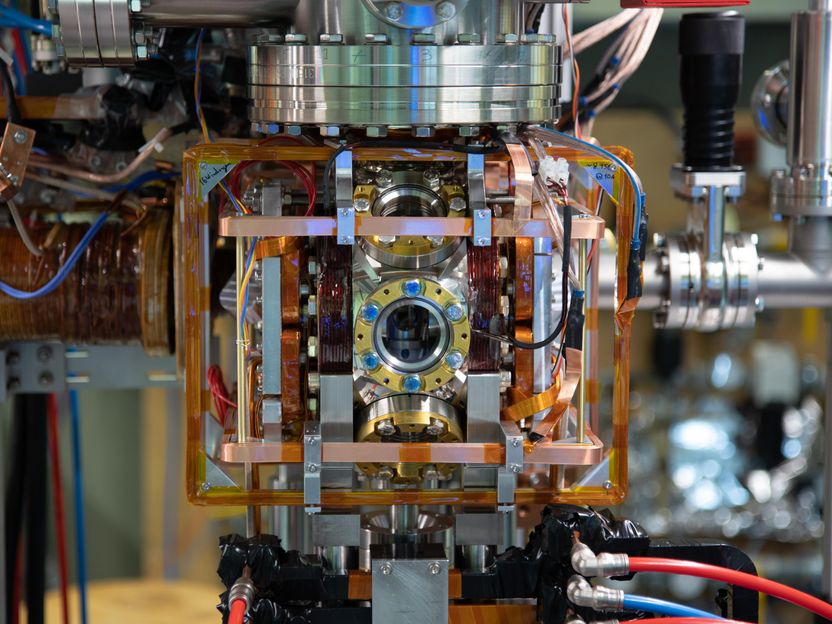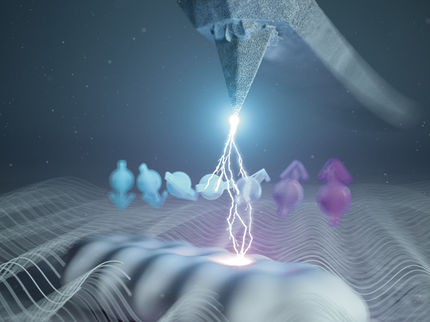Ions and Rydberg-atoms: a bond between David and Goliath
Anovel binding mechanism between small and giagantic particles detected
Researchers of the University of Stuttgart have verified a novel binding mechanism forming a molecule between a tiny charged particle and in atomic measures gigantic Rydberg atom. The scientists could observe spatially resolved the molecule with the help of a self-build ion microscope. The well-known journal “Nature” published the results on May 18, 2022.

Vacuum chamber. The electric field control and the first lens of the ion microscope are sitting in the center of the chamber.
Nicolas Zuber, Universität Stuttgart
When single particles like atoms and ions bond, molecules emerge. Such bonds between to particles can arise if they have for example opposite electrical charges and hence attract each other. The molecule observed at the University of Stuttgart exhibits a special feature: It consists of a positive electrically charged ion and a neutral atom in a so-called Rydberg state. These Rydberg atoms have grown in size a thousand times compared to typical atoms. As the charge of the ion deforms the Rydberg atom in a very specific way, the bond between the two particles emerges.
Rubidium cloud cooled down close to the absolute zero
To verify and study the molecule, the researchers prepared an ultra-cold rubidium cloud, which was cooled down close to the absolute zero at -273°C. Only at these low temperatures, the force between the particles is strong enough to form a molecule. In these ultra-cold atomic ensembles, the ionization of single atoms with laser fields prepares the first building block of the molecule – the ion. Additional laser beams excite a second atom into the Rydberg state. The electric field of the ion deforms this gigantic atom. Interestingly the deformation can be attractive or repulsive depending on the distance between the two particles, letting the binding partners oscillate around an equilibrium distance and inducing the molecular bond. The distance between the binding partners is unusually large and amounts to about the tenth of the thickness of a human hair.
Microscopy with the aid of electric fields
A special ion microscope made this observation possible. It was developed, build and commissioned by the researches at the 5th Physical Institute in close collaboration with the workshops of the University Stuttgart. In contrast to typical microscopes working with light, the device influences the dynamics of charged particles with the help of electrical fields to magnify and image the particles onto a detector. “We could image the free floating molecule and its constituents with this microscope and directly observe and study the alignment of this molecule in our experiment”, explains Nicolas Zuber, PhD student at the 5th Physical Institute, the results.
In a next step, the researchers want to study dynamical processes within this unusual molecule. With the help of the microscope, it should be possible to study vibrations and rotations of the molecul. Because of its gigantic size and the weak binding of the molecule, the dynamical processes are slower compared to usual molecules. The research group hopes to gain new and more detailed knowledge about the inner structure of the molecule.
Original publication
Other news from the department science

Get the chemical industry in your inbox
By submitting this form you agree that LUMITOS AG will send you the newsletter(s) selected above by email. Your data will not be passed on to third parties. Your data will be stored and processed in accordance with our data protection regulations. LUMITOS may contact you by email for the purpose of advertising or market and opinion surveys. You can revoke your consent at any time without giving reasons to LUMITOS AG, Ernst-Augustin-Str. 2, 12489 Berlin, Germany or by e-mail at revoke@lumitos.com with effect for the future. In addition, each email contains a link to unsubscribe from the corresponding newsletter.




























































